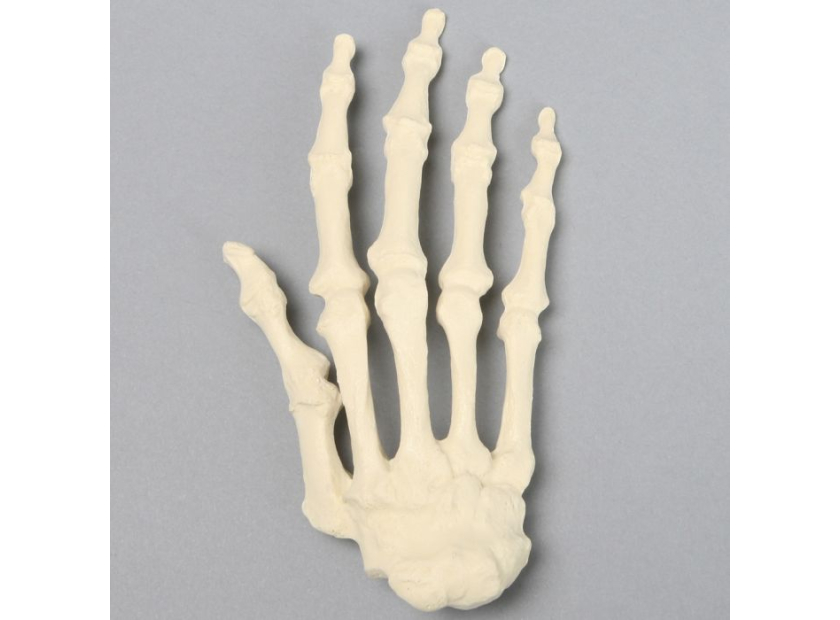Rheumatoid Arthritis Hand Model for Medical Training
Rheumatoid arthritis (RA) affects more than 1.3 million Americans. It is the most common form of autoimmune arthritis and often attacks the wrist, hands, and feet as well as the shoulders and knees. Rheumatoid arthritis hand models demonstrate how the disease causes damage to bones and the spaces between them. Anatomical models also excel at demonstrating the various treatment options available for combating this disease. Let’s take a closer look.
Hand Models For Rheumatoid Arthritis
Rheumatoid arthritis affects the following joints within the hand:
- Metacarpophalangeal (MCP) joints: Large knuckles where the fingers and thumb are joined to the hand
- Proximal interphalangeal (PIP) joints: Synovial joints between the two phalanges of the fingers. PIP joints are also known as middle knuckles; thus, the thumb has no PIP joint
- Wrist joints: Where the wrist's carpal bones join with the forearm's radius and ulna as well as with each other (e.g., carpometacarpal joint, radiocarpal joint, and intercarpal joints)
Rheumatoid arthritis seldom affects the distal interphalangeal (DIP) joints closest to the fingertips. However, when the large and middle knuckles begin showing symptoms of RA, then DIP joints are likely to exhibit symptoms as well.
Hand models help familiarize residents and medical trainees with relevant anatomical parts concerned with rheumatoid arthritis.
How RA Damages Hand Bones and Joints
Hand models depicting the ravages of rheumatoid arthritis on bones and joints help residents and medical trainees grasp the implications of disease progression.
- Stage 1: RA begins when the patient's immune system begins sending antibodies to the lining of the joints in the fingers, hand, wrist, and other joints. This action inflames the synovium (a connective soft-tissue membrane found in articulated joints), which releases chemicals that make surrounding tissue swell. What causes the immune system to attack healthy, native tissue is still unknown. Early-stage symptoms of rheumatoid arthritis include joint pain, stiffness, and tenderness.
- Stage 2: The chemicals released by the inflamed synovium begin to damage joint cartilage. Inflammation also affects nearby tendons, ligaments, and other tissues. The patient starts to lose range of motion in the affected area. RA usually affects the same joint on both sides of the body (e.g., right wrist, left wrist).
- Stage 3: This stage is characterized by severe inflammation that destroys cartilage and causes the joint space to narrow. When this happens, the bone ends meet and wear down. Rheumatoid nodules or visible lumps under the skin may develop. Symptoms at this stage include a further reduction in mobility and the development of joint deformities.
- Stage 4: At the end stage of rheumatoid arthritis, symptoms become chronically severe. Though inflammation stops, the joints become unstable and eventually stop working. Ankylosis may occur as the joints fuse together. Muscles become affected as well and lose strength over time.
RA Treatment
There is no cure for rheumatoid arthritis. However, there is a range of treatments designed to control symptoms and slow down the disease’s progression.
Models show how non-surgical treatment and medication address early-stage symptoms of rheumatoid arthritis.
Non-Surgical Treatment
|
Medication |
Medications like the ones below aim to get the inflammation under control:
Hand models show how controlling inflammation through the use of drugs helps prevent or slow down joint damage. |
|
Therapy |
Detailed anatomical models facilitate discussion on how therapy improves muscle strength and keeps joints flexible.
|
Surgical Treatment
Anatomical models can be used to show how the following surgical procedures address severe RA cases.
|
Arthroplasty |
A surgical procedure wherein the diseased parts or entirety of the joint are replaced. Arthroplasty reshapes bones in the joint to make room for synthetic parts. Joint parts or the whole joint can be replaced with metal, plastic, or carbon-coated implants. Discussion can emphasize the typical areas for arthroplasty, such as the proximal interphalangeal and metacarpophalangeal joints. Instructors can also use hand models to call attention to the thumb's ineligibility for arthroplasty (high lateral forces contribute to implant failure) as well as fingertips (joints are too small to accommodate implants). |
|
Arthrodesis |
A surgical procedure wherein diseased bone is removed and the neighboring bones are fused together. Arthrodesis may require using a bone graft harvested from the patient's pelvis. Models can be used to show how this procedure stabilizes finger joints and reduces pain in spite of limiting mobility. |
|
Synovectomy |
A surgical procedure wherein the inflamed synovial tissue and fluid are removed to treat joint pain and swelling. This procedure is recommended when chronic swelling of the synovium fails to respond to medication and rehabilitation. Models can be used to show how synovectomy can retard the effects of RA before bone changes occur in the finger joints. |
Hand models enable residents and medical trainees to appreciate the different treatment and surgical options for combating the effects of rheumatoid arthritis on hand joints and bones.
In summary, anatomical hand models depicting rheumatoid arthritis raise the level of medical instruction and training as well as patient education. Full-size hand models also reveal the extent of damage RA can inflict on affected joints and bones. Lastly, models help residents visualize the progression of the disease as well as available treatment options for patients.
Choose the Best-in-Class Anatomical Models
Sawbones designs and manufactures best-in-class anatomical models for residents, instructors, students, sales specialists, and more. We offer customized products including models and custom displays for residency program needs. Sawbones is a proud partner of several medical training institutions, including the Postural Restoration Institute® and Medical Sales College.
Sawbones offers best-in-class rheumatoid arthritis hand models for medical training as well as patient education purposes. For more information on our offerings or to talk about custom training models, contact us at 206-463-5551.








